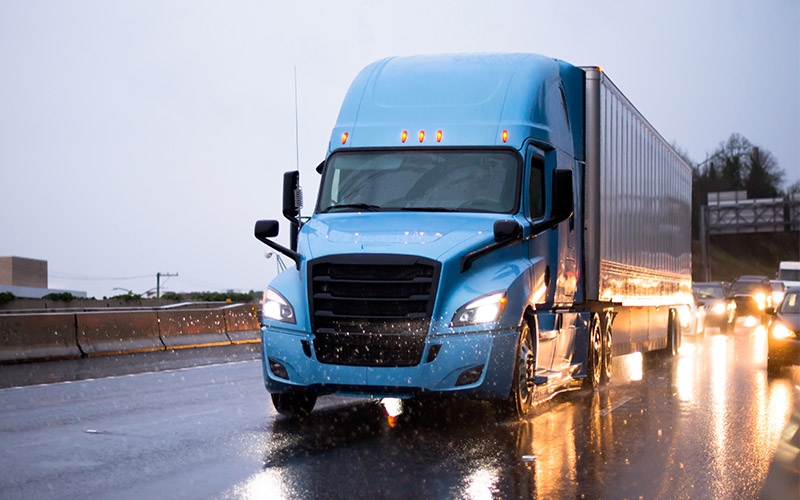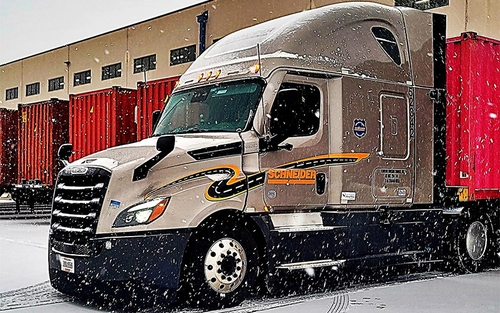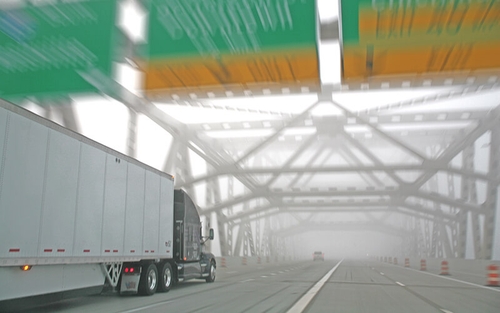Truck driving in the rain: 14 safety tips you should know


By The Schneider Guy
Estimated reading time: 3 minutes
Heavy rain can create some of the toughest conditions to drive a semi-truck in. As a truck driver, it’s important to familiarize yourself with steps you can take to stay in control when facing slippery roads.
Keep reading to see 14 safety for tips for truck driving in the rain that every driver should know.
How to prepare for truck driving in the rain
1. Know before you go.
As part of your trip planning, take a few minutes to check the weather along your route. Familiarize yourself with what conditions you may encounter by:
- Checking out the weather forecast, not just where you currently are, but where you will be driving through.
- Calling your state’s 511 number.
- Using one of the many trip-planning apps for truck drivers.
Be particularly aware of the potential for flash flooding during heavy downpours or freezing conditions when temperatures dip down. Rain from the day before may have frozen overnight.
Also, follow all the usual best practices for trip planning, including checking your GPS for possible road closures due to flooding. Plan ahead to avoid such areas.
2. Complete a thorough pre-trip inspection.
A pre-trip inspection should be completed no matter the weather conditions, but an equipment problem could be even worse in heavy rain. Make sure your truck and trailer are in good working condition by taking to time to do a careful pre-trip inspection.
3. Pack appropriately.
Ensure you have proper gear packed for every season and for the potential climate conditions you may be driving in. This is especially important if you are an over-the-road driver and travel to various parts of the country.
Make sure you have items such as:
- A jacket that can handle heavy rain.
- A rain poncho.
- Rain pants.
- An extra pair of gloves.
- Slip-resistant, waterproof boots.
- A flashlight with spare batteries.
Make sure you have a fully stocked emergency kit in your truck as well.
4. Make the final call.
If conditions are unsafe, you can decide to stay off the road. As a truck driver, your safety should be your top priority.
5. Remove distractions before driving.
Set yourself up for maximum focus on the road by:
- Setting your phone to “do not disturb” and putting it out of reach.
- Making sure your GPS is fully set up before leaving.
- Putting away beverages and snacks.
Driving in rainy weather safety tips
6. Keep your lights on.
It’s just as important for other motorists to be able to see you as it is for you to see them and the road. This goes for driving in rainy conditions both at night and during the day.
7. Keep your radio on at low volume.
Do this so you can track stations that provide weather updates and get alerts on the latest conditions.
The volume shouldn’t be so loud that you can’t hear what’s going on around you, like any approaching emergency vehicles.
8. Change speeds gradually.
Speed up and slow down slower than you normally would to prevent traction loss.
Only 1/12 of an inch of water on the road forces tires to displace one gallon of water per second to maintain contact. Take it slow to avoid hydroplaning.
9. Avoid driving into standing water.
Do everything you can to avoid driving through standing water, as doing so can obscure your vision and prevent you from seeing hazards, such as:
- Potholes.
- Debris.
- Washed-out roads.
Plus, you have no idea how deep the water really is. If you absolutely can’t avoid a puddle, just take it slow to maintain control.
10. Take it slow.
Sometimes a safe speed is far below the posted speed limit. Adjust your speed to the weather.
For example, Schneider’s “Take 5” safety tip advises taking at least 5 mph off your speed for each of the following situations when you encounter them:
- Driving in poor weather.
- Going around a curve.
- Hauling a light trailer.
- Being in heavy traffic.
11. Increase your following distance.
Schneider recommends seven seconds of following distance in good conditions. You should allow for even more time to stop in slippery conditions.
Since heavy rain reduces traction so much, consider doubling your following distance to give yourself enough room to stop.
12. Don’t use cruise control or your engine brake.
Leave your cruise control off so you keep a feel of the road and prevent your truck from hydroplaning.
Also avoid using your engine brake (“Jake brake”) on wet and slippery roads, as it could result in loss of traction and skidding.
13. Stay calm.
Staying patient and focusing on maintaining control will help you stay safe in poor driving conditions.
If you do start to hydroplane or skid, stay calm and don’t abruptly brake or turn. To avoid a rollover, keep your steering wheel straight and stop accelerating.
14. Know your limits.
If you are not comfortable to continue driving, get off the roadway safely and take a break until conditions improve. Find a safe parking lot (not on the shoulder) and let others know where you are and that you are safely parked.
Looking for more helpful safety tips?

Schneider Guy loves the "Big Orange." He's passionate about the trucking industry and connecting people to rewarding careers within it. He's been the eyes and ears of our company since our founding in 1935, and he's excited to interact with prospective and current Schneider associates through "A Slice of Orange."



